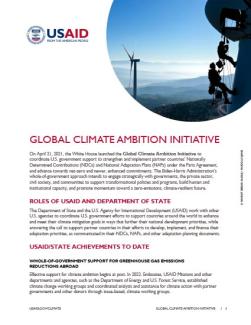Global Climate Ambition Initiative
Climate Change
Fact Sheet –
This whole-of-government approach intends to engage strategically with governments, the private sector, civil society, and communities to support transformational policies and programs, build human and institutional capacity, and promote momentum toward a zero-emissions, climate-resilient future.
On April 21, 2021, the White House launched the Global Climate Ambition Initiative to coordinate U.S. government support to strengthen and implement partner countries’ Nationally Determined Contributions (NDCs) and National Adaptation Plans (NAPs) under the Paris Agreement, and advance towards net-zero and newer, enhanced commitments. The Biden-Harris Administration’s whole-of-government approach intends to engage strategically with governments, the private sector, civil society, and communities to support transformational policies and programs, build human and institutional capacity, and promote momentum toward a zero-emissions, climate-resilient future.
Roles of USAID and Department of State
The Department of State and the U.S. Agency for International Development (USAID) work with other U.S. agencies to coordinate U.S. government efforts to support countries around the world to enhance and meet their climate mitigation goals in ways that further their national development priorities, while answering the call to support partner countries in their efforts to develop, implement, and finance their adaptation priorities, as communicated in their NDCs, NAPs, and other adaptation planning documents.
USAID/State Achievements to Date
Whole-of-Government Support for Greenhouse Gas Emissions Reductions Abroad
Effective support for climate ambition begins at post. In 2022, Embassies, USAID Missions and other departments and agencies, such as the Department of Energy and U.S. Forest Service, established climate change working groups and coordinated analysis and assistance for climate action with partner governments and other donors through issue-based, climate working groups.
New, and More Climate-Ambitious, Programming
With new vehicles in place for interagency coordination, additional resources, and technical expertise available within the U.S. government and through its implementers, USAID and State since COP26 (as of October 2022) have launched new, or refocused existing, assistance in at least nine additional partner countries to support implementation of their climate mitigation goals. There are ongoing efforts to enhance collaboration in 18 other countries.
New and Enhanced Resilience- and Adaptation-Focused Collaboration and Programming
With new vehicles in place for interagency coordination, additional resources, and technical expertise available within the U.S. government and through its implementers, State and USAID have launched in 2022 new, or refocused existing, assistance in at least 26 partner countries to address their climate risks.
Examples of New or Refocused Assistance
The Department of State and USAID are working with its Embassies and Missions to engage partner countries with their NDCs and NAPs as well as other climate related goals. Below are examples of how the Department of State and USAID have strengthening coordination and assistance around NDC/NAP implementation since COP26 (as of October 2022):
Comprehensive Action for Climate Change (CACCI)
Announced at COP26, CACCI is a joint climate initiative with regional and country level stakeholders to provide support to partner country governments to implement policies and programmatic investments; strengthen national, regional, and local capacity to meet NDC targets and develop NAPs; and provide broader climate and environmental policy support. Since COP26, CACCI has initiated activities in 12 countries in Africa, Asia, the Caribbean, and Latin America.
Mitigation: Expediting decarbonization in South Africa through the Just Energy Transition Partnership (JET-P)
In 2021, South Africa and several international partners, including the U.S. government, announced the Just Energy Transition Partnership (JET-P) which includes more than $8.5 billion to support the country’s transition away from coal power plants to cleaner fuel sources. This U.S. government collaboration with the South African government includes nearly $50 million of direct support to the JET-P program in South Africa. This funding, directed by USAID through Power Africa and aligned with the Just Energy Transition Investment Plan (JET-IP) will be deployed as grant financing to support the just elements of the JET-P that ensures workers and communities are not negatively impacted by the transition from coal to clean energy.
Mitigation: Meeting Climate Goals through Nature
Deforestation and land use such as agriculture account for a majority of emissions in low and lower-middle income countries, and the majority of tropical countries will rely on natural climate solutions to meet their mitigation targets. USAID is supporting countries like India to meet their NDCs by conserving forests and lands. In September 2022, USAID and the Government of India launched the Trees Outside Forests in India initiative, which is bringing together farmers, companies, and private institutions in India to rapidly expand tree coverage outside of traditional forests by 2.8 million hectares, an area roughly the size of Belgium. This work is expected to absorb 420 million tons of carbon dioxide equivalent over five years—equal to the emissions from running 22 coal plants for that time. The additional tree coverage will help to mitigate climate change and directly contribute to India’s NDC target of creating an additional “carbon sink” of 2.5 to 3 billion tons of carbon dioxide equivalent by 2030.
Adaptation: Building Resilience in Vulnerable Countries
USAID support in Tajikistan is strengthening the enabling environment for implementation of NDCs and NAPs into current and future planning at national, sub-national, and community levels for increasing resilience and food security. It is also helping build institutional arrangements to assist actors to mainstream climate policy that supports climate smart and green agriculture strategies at the regional, national, sub-national levels.
Challenges
We acknowledge that shifting governance, social, and economic structures to align with emission ambitions and climate implementation efforts are a long term and complex process with many challenges. Ongoing shocks and stresses, such as inflation, COVID-19, the conflict in Ukraine, and climate-induced events are all factors that need to be navigated. Nonetheless, the U.S. government remains committed to partnering with other countries to advance their greenhouse gas emissions reduction targets and build resilience through adaptation, particularly within small island states and other vulnerable countries.
Resources
White House Fact Sheet: President Biden’s Leaders Summit on Climate, April 3, 2021
USAID Press Release: USAID Announces New Targets to Support the Global Climate Ambition Initiative, November 8, 2022

